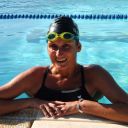I got a great question from Squidkid reader Rahul, who at 31 years age is not only learning how to swim for the first time, but working on freestyle or side breathing.
I am practicing regulary about four times a week … when I try to turn and take a breath I form an arch at my back that causes my entire lower body portion to fall … as a result I am unable to keep kicking … I have to stop immediately. Does this arch formation imply something is wrong with my swimming technique?
First, thanks Rahul for sharing and putting yourself out there, both here and in the pool. Here is what I suggest for Rahul:
- Do body comfort checks. New swimmers, understandably, tend to be more tense in the water. The problem with being tense is your muscles lock up; and if your muscles lock up your body becomes a rock. I would practice floating on your back or doing gentle Elementary backstroke laps on your back, breathing in and breathing out, making sure every single muscle in your body is loose before you attempt freestyle. Only in this state can you achieve a body that floats when you swim.
- Don’t lift the head. By Rahul telling me his body forms an arch on the back when he tries to breathe says to me he is still straining his head and neck to reach air. When the head is up, the legs automatically sink down. The head nor neck doesn’t lift in the freestyle — the entire body rolls so the mouth is out. Think of the water as a warm blanket that you just don’t want to lift your head/ear from when you roll over for a breath. Look to the side or almost behind when your mouth reaches air. Roll, roll, roll.
- Muscular people have to work harder to float. I’m thinking Rahul might have bigger quads or legs and not a lot of body fat. So his build could be another reason why his legs are sinking. Grab the kickboard and practice flutter kicking with loose legs — you have to learn how to work with what you’ve got below before you can successful match the arms with the legs.
- Most swim questions get answered after pushing through the problem. I have no doubt Rahul is doing his best, but you have to physically push through the problem. Exert more energy. Be willing to get out of breath. Don’t stop until you reach the end of the lane. Swimming takes exerting major patience and practice, not knowing it takes major patience and practice. The answer isn’t solved in the head through thinking — it’s discovered in the body through doing.








